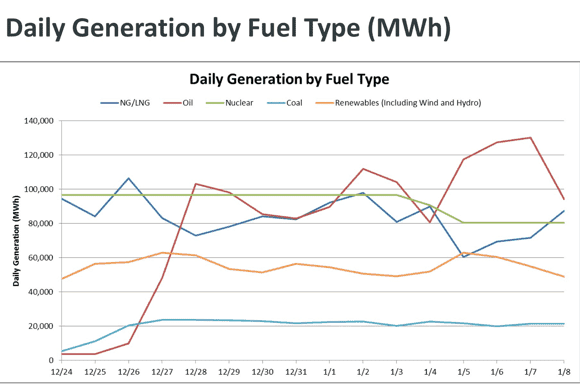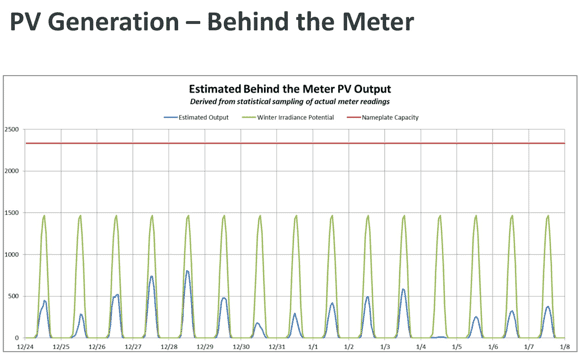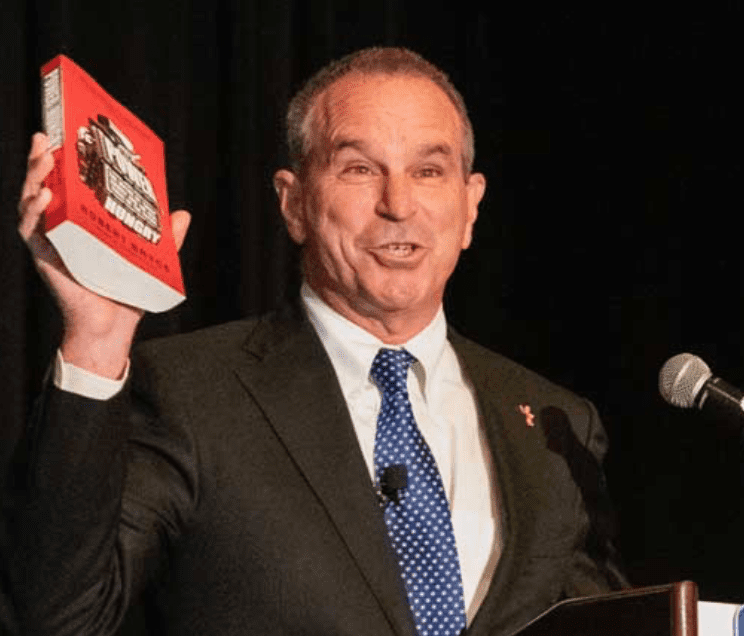Performance of the New England power grid during extreme cold Dec 25-Jan 8
The Independent System Operator for the New England power grid (ISO-NE) has produced a summary brief describing the challenges associated with Arctic Outbreak 2017-2018, a period of substantially below normal temperatures that lasted from Dec.25, 2017 until Jan. 8, 2018.
After describing the intensity of the cold wave with a number of graphs, charts, images and words, the brief made the following sobering statements about the fuel mix used to supply power demand.
- Overall, there was significantly higher than normal use of oil
– Coal use also increased over normal use- Gas and Oil fuel price inversion led to oil being in economic merit and base loaded
- As gas became uneconomic, the entire season’s oil supply rapidly depleted
The brief includes the following graph showing the daily electricity contribution in MWhrs from various fuel sources.
A major contributing factor to the rapid depletion of fuel inventories was the sharp increase in oil-fueled power production starting on Jan 4. Nuclear electricity production dropped on Jan 4 by about 8,000 MWhrs and dropped again on Jan 5 by roughly the same amount.
Pilgrim Nuclear Power Plant was scrammed at about 1:15 pm on Jan 4 because one of its two large transmission lines fell down during Winter Storm Grayson. The plant, which had been running continuously at or near full power for 225 days, was not returned to service until Jan 10 and did not achieve full power output until Jan 12.
The majority of the power that had been supplied by Pilgrim was replaced by burning more oil. As the winter storm moved away from the region, generation from wind also fell.
The below pair of charts from the brief should also be food for thought for those who claim that what regions like New England really need is more solar power.
Fuel supply challenges
Though there were no large scale power outages, keeping power flowing to customers required some heroic efforts on the part of fuel truck drivers, Coast Guard ice breakers, and power plant operators.
It even required the suspension of usual rush hour traffic procedures that prevent the Weymouth Fore River Bridge from opening. As the Coast Guard explained in its press release announcing the temporary allowance for critical vessel traffic, “…recent extreme weather and ice accumulation in the Weymouth Fore River has made it difficult for tank vessels and barges to deliver time-sensitive resources such as home heating oil and kerosene, and fuel for power plants and public transit.”
Even though road conditions were treacherous, fuel trucks were pressed into overtime service to prevent the catastrophic consequences of running out of fuel during an event where temperatures were often well below 0 ℉ and the wind was howling. Keeping fuel oil supplied to homes, businesses and power generators required the suspension of normal driver rest requirements.
The ISO-NE brief describes trucking as the main fuel supply logistical constraint and states that:
- Carriers are at their physical limits
- Drivers need time off to rest, even with State Waivers in effect
- The break in the weather this week [beginning Jan 8] will provide much needed relief
Both the rush hour bridge openings and the suspension of truck driver rest rules had the potential to alert large segments of the population to the fact that their electricity supply system was closer to collapse than sunny summary statements of “reliable performance” might imply. Fortunately, no tragic consequences occurred – this time.
Not a perfect storm
Though the weather event was unusual, it was certainly not unprecedented. It’s no surprise to note that it sometimes gets cold and dark in New England during the winter. There are some who incorrectly label the entire event as a “bomb cyclone,” overlooking the fact that moniker only applies to the rather strong nor’easter that raced up the Eastern Seaboard on Jan 4.
Others with longer memories apply a more accurate label of “New England winter,” to reflect the fact that winter weather can vary from year to year, but it is something that requires routine preparations. It isn’t a surprising act of God when it is a little colder than average, just as it shouldn’t be surprising when a winter ends up to be a bit warmer than average.
Senate Energy and Commerce Committee Hearing
On Tuesday, Jan 23, 2018, Senator Lisa Murkowski, the Chair of the Senate Energy and Natural Resources Committee, convened a hearing to discuss the performance of the electric power grid during certain weather conditions. Most of the testimony and questioning focused on the two week period from Dec 25-Jan 8, but the nature of the topic allowed participants to expand the discussion to other memorable weather events including droughts, heat waves and tropical cyclones.
Though it’s possible for people to watch the archived video of the hearing and find reassuring commentary confirming whatever biases they have, I watched with growing concerns for New England’s ability to handle routine weather events without major economic disruption and potential loss of life. (I’ll admit that my training as a professional worrier – also known as an engineering officer in the Nuclear Navy – biases me toward concern when others are complacent.)
Mr. Gordon van Weile, the president and CEO of ISO-NE, provided both stark warnings for the future and a reminder that he has been sounding the warnings since at least 2013 without any substantive action being taken. Each time a non-gas fired generator retires, the situation gets more fragile. That is especially true when the retiring resource is a nuclear plant that has been reliably running at full power 80-95% of the time.
When there is a sustained cold weather event, natural gas availability hits a virtual wall where prices rise at astronomical rates indicating that there is no gas left to be purchased, no matter how much the buyer is willing and able to pay. When prices in a region rise to be 20 or more times higher on one side of a pipe compared to the other, it means there is no more room in the pipe.
Mr. van Weile described the precarious nature of New England’s fuel supply during the cold spell.
While we weathered a stretch of extremely cold weather and a blizzard, we remain concerned about resupply of these resources during the remainder of the winter season and are in close coordination with state and federal officials about the challenges of ensuring adequate oil supplies to the region. Finally, given the fuel constraints, the rapid depletion of the oil inventory, and the reality that resupply was several days away during the peak of the cold weather period, our biggest operating concern was that we would experience a large, multi-day system contingency during this period or that oil-fired generators would run out of fuel before they could be resupplied.
Pilgrim’s Jan 4-Jan 9 Shutdown
It’s difficult, even during a period of incredibly steady performance by 98 out of 99 nuclear plants, to engage in discussions about the importance of nuclear energy for the resilience of the U.S. power grid when the 99th plant shuts down unexpectedly and remains shutdown for what is now going on six days.
paraphrasing a nuclear industry cliche, during a weather event an outage anywhere is an outage everywhere. That is especially true when it is unplanned and lasts an unexpectedly long time.
On the afternoon of January 4, the Pilgrim Nuclear Plant operators manually shut down their power station as a result of what I would term an overabundance of caution and fear of criticism from life-long opponents. The plant was returned to service almost six days later. Though the transmission line was back in service in approximately two days, the shutdown was extended because the plant operators decided to repair a small steam leak.
Aside: Steam plants leak. It is the nature of the technology. That is especially true as plants age. In many cases, the leaks are a minor annoyance and repairs can be deferred with no fixed deadline. It’s dependent on situation; during one of my patrols we managed a rather irritating steam leak for more than a month so we could complete our scheduled mission. End Aside.
Investigation into details of Pilgrim’s shutdown
The specific instigator of the decision to shut down was the loss of one of two 345 kV transmission lines that allow Pilgrim to deliver its power to the grid.
There is no external or regulatory requirement for a nuclear plant of Pilgrim’s design to immediately shut down in such a circumstance. The required action is to work diligently on restoring the line and to limit the duration of operations with just one outgoing transmission line to a period of 72 hours. If the nature of the failure is such that it is unlikely to be resolved in the allowed time, most operators will choose to shutdown once that fact is known.
Pilgrim, however, has a local procedure that requires a prompt manual shutdown if it loses either one of its outgoing transmission lines during a storm event. According to Patrick O’Brien, that procedure was developed based on past operating experience. When one transmission line goes down, the plant is in a condition where the loss of the second line would result in an automatic trip and a more significant cycle on the plant’s systems.
In response to a question about the possibility of delaying such a shutdown in a case where the grid operator had declared that the power was needed and shutdowns should be avoided, Mr. O’Brien stated that there is no process to allow situational judgement by plant operators. He acknowledged that there is a process by which a local procedure could be changed, but that requires a full impact review that cannot be waived.
During most of the period that Pilgrim was shutdown and completing the deferrable repair, the wholesale price of electricity in New England and New York averaged approximately $200 per MWh. As demonstrated during a separate period of demand caused by similarly cold weather with the plant operating, it is reasonable to state that lack of supply from Pilgrim added something close to $100/MWe to wholesale power prices.
If this analysis is correct, the loss of Pilgrim at a time of high demand cost New England customers approximately $1.5 million per hour. (Roughly 15,000 MW of demand x $100/MWh) On the other side of the ledger, a number of entities associated with fuel deliveries and power generators collected an extra $1.5 million per hour for six profitable days.
When operating, Pilgrim’s daily electricity production is the energy equivalent of approximately 9,300 barrels of oil. Delivering that much oil to the generators that needed to run to replace Pilgrim required the logistic supply capacity equivalent of almost 50 large tanker trucks each day.
Pilgrim is scheduled to permanently close in early June 2019. Entergy, the plant’s owner, has determined it is not profitable enough to overcome the costs, risks and managerial annoyances associated with operating the plant.
A loud and persistent subset of its neighbors has been vocally opposed to the plant’s existence since before it was built.
Some of those neighbors vehemently and publicly protested Entergy’s failure to shutdown the plant before the winter storm hit, claiming that the operators were putting profit over safety. When the plant did shutdown, those opponents did not petition for it to be restarted as soon as possible to keep the power grid secure, air pollution levels down, and electricity prices in check.
Instead, they staged a protest suggesting that the plant should be forced to remain shutdown and enter decommissioning a year ahead of the already premature date.
Here are excerpts from an email from Dianne Turco, the executive director of Cape Downwinders, explaining her organization’s position regarding Pilgrim specifically and nuclear energy in general.
As an organization, Cape Downwinders is focused on public health and safety regarding the operation of Pilgrim. We support clean, green, renewable, and safe energy. Nuclear certainly does not fit in that category.
…
It should be no surprise if Pilgrim goes down during a storm. That is one of the reasons why they are rated so low. In fact, in the past few storms, Entergy voluntarily shut Pilgrim preemptively. But not this time. They took the risk that threatens our entire region. Also, Pilgrim is not reliable baseload energy. When needed the most, Pilgrim has shutdown during blizzards and during the warmest days of the year due to temperature rise in Cape Cod Bay that interferes with the cooling water.
…
Cape Downwinders position on energy is certainly no nuclear. Release of radioactive isotopes into the environment are part of the operation of a reactor. The National Academy of Science has determined there is no safe dose of ionizing radiation. Studies have shown cancer increases around nuclear reactors and after nuclear accidents. Dr. Richard Clapp, who was head of the MA Cancer Registry, found the closer one lived or worked in relation to Pilgrim, the incidence of cancer was 400% higher. We need clean, green, safe, and renewable energy for a healthy planet. Neither nuclear nor fossil fuels meet that criteria.
I wasn’t too surprised when she did not respond to my follow-up email.
Ms Turco
Thank you for your response.
This morning, when I checked the dashboards published by ISO-NE giving real time information on electricity and fuel sources, only 7% of the grid supply came from non hydro renewables. Nuclear and gas were each supplying 33%, oil and coal combined for 27%.
93% of that 7% came from burning wood, refuse or landfill gas. 7% came from wind, 0% from solar.
You have the luxury of advocating. Fortunately, there are other people working hard to supply reliable electricity from capable sources – nuclear, natural gas, oil and coal.
The NAS says that evidence shows that radiation doses above 100 mSv can increase the risk of cancer. They also say that the risk increase is proportional to dose.
They say there is not enough evidence to conclusively show a threshold, so they make a conservative assumption and extend the proportional line down to zero risk at zero dose.
That means that risk is never zero, but approaches zero as doses approach the range of public exposure from nuclear power plants.
It is much, much lower than the health risk of exposure to below freezing temperatures.
Pilgrim is one of the worst licensed nuclear plants in the US, but it isn’t unsafe any more than the worst player in the NFL is an unhealthy couch potato.
Rod Adams
With persistent opponents like Ms. Turco, it’s understandable that a company might make the decision to exit. Operating power plants is hard enough when people occasionally express their appreciation for reliable service. It can be downright depressing to field sharp criticism for being unreliable after running for 226 days straight and maintaining a capacity factor in the neighborhood of 85% over a sustained period of years.
Why did Entergy take its time in returning Pilgrim to service?
Despite several attempts, I have been unable to determine the specific reasons why Entergy decided that they should take the opportunity presented by the downed power line to perform a repair that kept them from collecting revenues associated with generating power during a time of high demand and high prices.
It’s not a simple task to determine just how much money Entergy left on the table by not operating. It isn’t correct to simply take the wholesale price history and multiply it by Pilgrim’s 685 MWe capacity because the prices would have been lower if Pilgrim had been operating.
However, it’s clear that the steam leak repair cost several million per day in forgone revenues. Perhaps there were people in the decision chain that were reluctant to maximize their profits in the plant’s final years of operation because they did not want anyone to suggest that the shutdown decision was based on economics that had been overcome by events.









The depletion of New England’s oil stocks from 68% to 19% (down 49%) in a matter of days is frightening. A little longer and the system would have run below minimum operating levels and TSHTF.
This problem will be greatly exacerbated by the scheduled closures of Pilgrim and Indian Point (especially the latter). If Pilgrim is equivalent to 9300 bbl/d, then Indian Point is equivalent to roughly 3x as much. Adding 37,000 bbl/d of oil demand during periods of gas network congestion would burn through reserves at lightning speed. Had those closures already occurred, the system would have had to go to rolling blackouts.
The necessity of the 90 day on-site fuel rule proposal is suddenly laid out in stark relief. It is time for the FERC to reconsider its rejection. It is also time to reconsider all pending nuclear closures and immediately change NRC rules to allow recommissioning of closed plants under their original license terms.
Last, am I the only one who noticed that there were wind-power curtailments due to transmission constraints despite the dire situation at ISO-NE? Those curtailments reached 200 MW at times. That’s power that was literally left on the table and could probably have been scooped up for next to nothing. There’s got to be some way to make productive use of it.
Now imagine that the “reserve stocks” were composed of storage batteries (assuming such is possible for grid-scale applications, which has not been demonstrated) charged from solar panels and windmills, instead of oil in tanks somewhere. Depletion would occur overnight instead of over days. Bring on the rolling blackouts. I’d put Diane Turco and her friends at the head of the list for load shedding. Maybe put a mimic of the amp-hour battery reserves meter online for all to monitor. When it reaches zero, their computer shuts down.
Computer? Shut down her heat, lights and water too. Make her endure the conditions she wants to inflict on everyone.
Given the capabilities of smart meters you could actually do this to her electricity. It would be funny to see how long she held out before saying uncle.
Wonder if the Envirowhackos have taken the data above and calculated how many Wind Turbines and Solar panels will be needed to provide the needed electricity? I have lived through at least four winter storms in the NE over a period of ten years that were very similar to that storm with similar energy problems.
I lived in Connecticut for five years and New Jersey for another five years after that. Both of my homes were heated by fuel oil, as it was much cheaper than NG. But I learned my very first winter that at the first report of an approaching winter storm to call the fuel oil company and have them top off the tank. There were two major reasons for this. If you wait till the tank is low and needs filled, if it happens to be in the middle of the storm you could pay near twice as much for the oil. Second reason is that once I was told that they had no oil for at least three days. However, I had a family with three young children. While growing up on the farm we would use the fuel oi in our tractor when the tank was empty. So thinking they were the same I drove to the gas station and got several five gallon cans of diesel fuel. Although it burned, it did not have near the heat output of the fuel oil, but at least kept the house livable – with sweaters and extra blankets! My neighbors that had NG had to buy a Kerosene heater and kerosene the keep their home warm – which were selling for a premium during the storm, if you could find them.
How did the wind turbines perform during this period?
OT: Anyone have any info on the status of Sanmen?
Good question.
Unsurprisingly, wind production included sharper and less predictable up and down ramps than solar.
https://twitter.com/atomicrod/status/956442121938063360
Bet you never thought you’d see the day they’d get 500-800 MW from wind for sustained periods. Have to admit if they triple the wind capacity, oil, gas, and coal could more easily fill the gaps.
Sanmen has been done since late summer. It’s been all politics since then as to when they’d fuel and start up. Very frustrating for those of us who worked on it. I think we’re getting close though.
@Cory Stansbury
Not terribly shocking to hear that there are politics associated with obtaining the final permissions to start up a nuclear power plant. Especially when it is an FOAK model of an imported, competitive technology to domestically available models.
I’ve never had a lot of trust in the Chinese government; I would not put it past them to exaggerate the challenges faced in building, starting and operating Westinghouse AP1000 reactors.
All the more reason for customers to select CAP1000 or Hualong One instead.
Nitpick: You’ve got the date of Senator Murkowski’s hearing written as 2918. Pretty cool, if you can peer 1000 years into the future. A little surprising that Murkowski is still alive 1000 years hence, but encouraging. If she can hang on that long, perhaps I can as well… 🙂
Thank you for continuing to bring the facts out into the light. Unfortunately, those paid to oppose nuclear will continue to be immune to facts. Is there any chance of getting a guest editorial or article in some of the regional papers? Get the residents’ peril written somewhere they might read about it?
@Jeff:
You can lead a man to wonder, but you can’t make him think. Facts don’t change our minds. I’ve been in this area only since April. There’s a mind-set. I don’t know how universal, as I’ve only a sample of two. Both intelligent science-types. Both can do math.
But they don’t. Over lunch one overcast day in an overcast week in overcast Bedford, discussing energy. Pointing out the deli window one asked, “So what is the solar Cf weeks like this?”
“Not much. Doesn’t need to be. Plenty of sun in the desert southwest. 90% of the days are sunny. Just get it from there.”
The other was an online discussion on a technical site, the question being from where the clean energy would come after Pilgrim went south? This was after having cited what had happened after Kewaunee closed, SONGS shuttered, and Vermont Yankee yanked:
“Local microgrids. Don’t worry, it will all work out.”
Pretty much by fiat: New England says no to natural gas, yes to renewables. (E&E News, October 2016.) Seriously.
Should we accept that these people know what they want and deserve to get it, good and hard?
Or is this matter too important to let them serve as examples to the rest of us?
Problem I have with these “fairy dust” “Micro Grids” is that they increase the need, more than doubling the number of new transmission lines than presently existing transmission infrastructure. Reviewing the ISO-NE report they mentions several multiple events in neighboring areas, Next time you drive around look at where the transmission lines are. Notice that there are often two or three sets of transmission lines running parallel for long distances, I recall in particular three 500Kv transmission lines running from Joliet to Chicago. A “Micro Grid” is going to require almost a spiderweb like system of transmission lines. This will mean many lower voltage transmission lines on essentially every major street and highway throughout your community. And that means many millions of dollars building those lines and more millions on “Mini Substations” to protect and switch the power to where it need to go.
The present lines and substations are also designed for delivering power in one direction and one direction only. Thus many more $millions will be expended to direct this power where it need to go and not dump highly destructive amounts of current onto a failure that “appears” to only be a sudden increase in needed power because of the loss of a PV network from a cloud passing over, when in reality it is a downed line.
@E-P
It’s far too important. I doesn’t serve as example to you, or me, or to essentially all other Rod’s readers. Or James Conca (mostly).
I’m always impressed at the patience and equanimity with which Conca answers his critics. Rod and Meridith Angwin as well. Michael Shellenberger and Ben Heard. Why is Heard often considered the most dangerous enemy of the anti-nuclear movement? Watch his videos, listen to him talk. Or The Atomic Show. James Hansen is dispassionate as well, but its not the same. He may as well be invisible. Facts don’t change our minds.
What does? I’ve backed off a bit while pondering that one. I’ve read and re-read Rod’s letter to Ms. Turco, searching for question marks.
Didn’t find one; suspect there’s a reason. Could it have been better? The Monday-morning quarterback within suggests it might. Though NAS was well-covered, perhaps a brief sentence to the effect
Report of the United Nations
Scientific Committee on the Effects of Atomic Radiation,
Fifty-ninth session (21-25 May 2012) pg. 10.
In other words, there is a threshold.
But wait! That’s not very brief! Coach reminds me attention spans are short, time had run out, and Rod was our man on the field.
I should shut up and tend my own backlog.
@Ed Leaver
A “brief sentence to the effect”, eh? As you imply, the laboriously precise language of the UNSCEAR report isn’t exactly that. Such language has its place, but not in speaking to ordinary people. I’ve tried to get it down a bit:
Translation: Radiation is all around us in nature. We have never been able to measure any bad health effects from it, even where the levels are high (up to 100mSv per annum). There are too many other real and worse causes of bad health.
Translation: And so it’s nonsense to fabricate an alarming-sounding problem about radiation at these low levels, when there isn’t one.
Does that sound about right? Short enough not to get a TL;DR response?
So 90% of the days in the desert southwest are sunny. That’s probably true. But there is this natural phenomenon called night, which happens at least once a day for about half the day. Last I checked, PV solar output was pretty limited during that time.
I had a pixie dust-type make the same argument with me, just get the solar PV from the desert. When I told him of the night effect, all I got was a blank stare. Another whacko type told me he had figured out that he could get all his electric car recharging from the PV panels he was going to put on his garage roof. I knew he worked during the day so I asked him if he planned to drive his electric to work. He did. But that was no big deal because he was going to recharge his EV overnight from the PV panels.
Doncha just love these people? They’re so pathetic sometimes, its almost funny.
@Ed Leaver
““Local microgrids. Don’t worry, it will all work out.””
You gotta love your faith based energy systems…
It’s kind of like when I point out that logically, automation is going to reduce the needed work force to a shrinking fraction of the number of people who need jobs, and someone invariably points at the agricultural/industrial revolution and states that new jobs will appear. Faith based economics.
Sigh. These people were presumably trained to do analysis and should know that not checking the actual numbers is a recipe for disaster.
I too wonder what is happening at Sandmen. It was to go live in 2017.
Sanmen has not received permission to start the nuclear fuel loading process. No specific reason. Chinese Nuclear Regulatory Board demanded additional tests, which Sanmen passed, but still no decision from the Board.
China is traditionally very bureaucratic, and sadly delays like this is not uncommon in any sector.
Thanks
It is interesting to speculate about upcoming months. The 2nd AP1000 should be finished now and 6 months from now 2 more should be finished. I would start one up each 6 months.
It certainly sounds like there may be some cold days without furnaces in the new England area in the next few years. When the outage happens, this may be the time to send Dianne Turco a letter simply asking her if this ever happened when the nukes were operation. Then ask her which is more dangerous a minuscule amount of radiation or becoming a human popsicle.
The term “steam leak” lacks detail of severity.
As a BWR Operator, I know that plants are equipped with High Energy Line Break (HELB) Isolation functions that are designed to protect Safety Related Structures, Systems, and Components from the effects of a substantial “steam leak”. Operators can evaluate the severity of a steam leak in a HELB instrumented system by parameters approaching an alarm or isolation set point. We monitor system flows and delta flows from one end of a system to another, ambient temperature and delta temperature (within a space or ambient to cooling water dT). The instrumentation is set to trigger isolations to prevent ambient conditions violating Environmental Qualifications (EQ). Some leaks just happen to be easier to find when at low power or shut down due to Heater Bay access restrictions at high power.
There are leaks. And then there are LEAKS requiring a Secondary Containment EOP entry – which may eventually require a shut down. Insufficient detail in the press to judge if startup delay was warranted. Pilgrim is ran by sharp operators. I will implicitly trust their judgement.